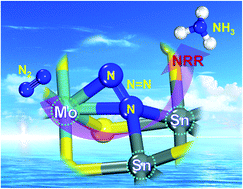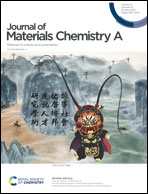Mo-doped SnS2 with enriched S-vacancies for highly efficient electrocatalytic N2 reduction: the critical role of the Mo–Sn–Sn trimer†
Abstract
Vacancy engineering and heteroatom doping are two effective approaches to tailor the electronic structures of catalysts for improved electrocatalytic activity. Herein, these two approaches were rationally combined to modulate the structure of SnS2 toward the N2 reduction reaction (NRR) by means of Mo-doping, which simultaneously induced the generation of enriched S-vacancies (Vs). The developed Mo-doped SnS2 nanosheets with enriched Vs presented a conspicuously enhanced NRR activity with an NH3 yield of 41.3 μg h−1 mg−1 (−0.5 V) and a faradaic efficiency of 20.8% (−0.4 V) and are among the best SnS2-based NRR catalysts to date. Mechanistic studies revealed that the co-presence of the Mo dopant and Vs enabled the creation of Mo–Sn–Sn trimer catalytic sites, capable of strongly activating N2 even for the cleavage of the N![[triple bond, length as m-dash]](https://www.rsc.org/images/entities/char_e002.gif) N triple bond to the N
N triple bond to the N![[double bond, length as m-dash]](https://www.rsc.org/images/entities/char_e001.gif) N double bond at the N2 adsorption stage, consequently leading to a downhill process of the first hydrogenation step and a largely reduced energy barrier.
N double bond at the N2 adsorption stage, consequently leading to a downhill process of the first hydrogenation step and a largely reduced energy barrier.

- This article is part of the themed collections: 2020 Journal of Materials Chemistry A most popular articles and Journal of Materials Chemistry A Lunar New Year collection 2021


 Please wait while we load your content...
Please wait while we load your content...